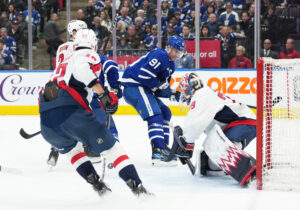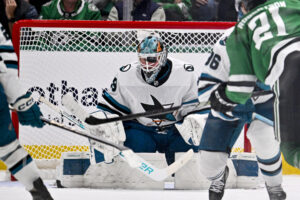Thank you to LeadOff Sports Marketing for all of the help with this article. LeadOff Sports Marketing serves as the family advisor for Yusaku Ando, among many other Japanese players playing in North America.
16-year-old Yusaku Ando is making waves in the prospect world, following his commitment to Minnesota State University’s D1 hockey program. The quick NCAA commitment followed a terrific rookie USHL season from Ando. At the age of 16 – one of only 16 2003-born players in the entire USHL, excluding the USNTDP – Ando scored 25 points in 40 games.
As the third-youngest player in the league, Ando’s point totals were the highest of any 2003-born player in the USHL last season; again excluding the USNTDP, although only two 2003-born USNTDP players managed more points than Ando: Jack Devine and Sasha Patsujov, who both recorded 26.
It was a terrific rookie season from Ando. While it doesn’t solidify a top-prospect title, it was enough to earn the young forward a college commitment and gain the eye of many of the world’s prospect writers. It has also set Ando up as one of the many stars leading the charge for Japanese hockey: the world’s greatest up-and-coming hockey country.
A Look at the Rise of Japanese Hockey Through One of Its Stars
Ando’s Move to North America
Many international players are faced with the decision of if and when to move to North America for hockey. The level of competition is much greater than anywhere else in the world. The chances of getting notices, and pursuing a career in hockey, are also much higher.
Ando made his choice to move in the 8th grade, saying, “I first came to Canada when I was in the 6th grade to participate in a tournament organized by Pat Quinn in Vancouver. Then I moved to Quebec when I was in the 8th grade and played for a local team there for a year.” When asked if it was a hard decision, Ando had a fairly terse reply: “It wasn’t that difficult. Actually, it was easy for me because I wanted to play more competitive hockey.”
Challenges in the USHL
That’s exactly what Ando has managed, playing in one of Canada’s premier prep leagues in Kelowna before moving on to the USHL. The biggest difference between North American players and those in Japan? Their size. “Players were bigger and physically stronger.” For a 5’7″, 147 lb (170 cm, 67 kg) winger, this increase in size can mark some challenges. Last Word on Sports’ own Ben Kerr said this is likely why he hadn’t popped up on many radars until this season. “He’s also physically small and slight which probably led to skepticism and why he was drafted so late in USHL draft (329th overall in 2019 USHL Draft).”
For Ando, who is emphatically dedicated to a pursuit of always improving, facing this heavy size is priority-number-one as he is tasked with learning to play the more to the North American style. “I’ve just been trying to understand how my coaches have wanted me to play. I think that has been working. Also, I started seriously working out after moving to North America. I have been getting gradually stronger.”
Issues Facing Japan
Ando cites this drastic size difference as one of the biggest things separating hockey in Japan from the world’s hockey powerhouses, saying Japan needs, “more battle and skill drills… playing more physically.”
But the size, or even slight differences in play, aren’t the largest issues. The bigger worries come in the logistical side of things. Ando also pointed out other needs: “Japan needs more players playing abroad such as in North America… they also need a better player development system.”
Of course, there needs to be exposure to hockey for any progress to be made. Following a recent trip to Japan, Kerr said, “I was in Japan in January and trying to get any coverage of the NHL, or any hockey league was near impossible there on any of the normal tv channels. Everything had to be through the internet. It also wasn’t obvious to me where there were even rinks to play. It’s almost an afterthought there right now. Keep in mind I saw the NFL, the English Premier League, the NBA, and MLB all had a presence. But anything hockey related? No… So accessibility and visibility is a huge issue.”
Of course, plenty of other issues are present. But, ultimately, the weight sits on the shoulders of the naturally-gifted stars, like Ando, that Japan has to offer. Their transition to North America, and eventually to the NHL, will create a path for all young players in Japan. The roles of these young hopefuls are truly significant for Japanese hockey moving forward.
The Uphill Climb
Ando is entirely aware that he represents Japanese hockey’s rise. He also knows the fight won’t be easy. He said, “it feels good [to represent them]. At the same time, I have to improve much more so that I could contribute more to Japanese hockey.” With that in mind, the thought of Japan reaching the level of hockey giants like Germany and Finland isn’t out of the question. Ando comments that it’ll happen one day. “To achieve that, I and some other players who play abroad have to improve. I would like to play against those countries in the top division of the World Championship and Olympics.”
Ando and his contemporaries are paving the way for generations of Japanese hockey to come and his humble, determined mindset towards it shows the true devotion that he, and Japan’s hockey world as a whole, has to the sport. It is the exact mindset that is needed to transform Japanese hockey.
Of course, plenty of actual hockey moves will help things along. Kerr mentions the addition of coaches from the US, Canada, and Sweden moving their talents to Japan could provide much-needed aid, similar to what Canadian Mark Mahon has offered to the Japan international team in recent years. Kerr says, “It’ll teach their players and coaches how to develop high-level skill… Until that happens, the hope is a natural talent becomes good enough to develop in Japan and then come over to a more traditional hockey country (as Ando did by going to a Canadian prep school before the USHL) and then develop into a star. You need that first big spark to ignite a fire.”
Shared Opinion
All of these issues are highlighted beautifully in an article from the great Steven Ellis, who goes more in-depth with each of the issues facing Japanese hockey. Ellis resonates with many of the fixes that Kerr mentions and further highlights the amazing prowess of Ando. The article does a great job of further highlighting the issues mentioned.
The Bright Light
The future is undeniably bright for Japanese hockey. Their women’s team set hockey history in 2020, becoming the first Asian team to win an Olympic Gold Medal in the 2020 Winter Youth Olympic Games. It was an exciting, endearing run by the women. A run that was not fortunate enough to receive the international recognition it deserved.
But despite the lack of jaw-dropping press, the admiration of the women representing their country held up the pride that’s become associated with Japanese sports. It marked the defiant first step in the rise of Japanese hockey. Now, on the back of rising North American stars like Yusaku Ando, the movement is taking its full form.
Yusaku Ando
The future for Ando as a player seems just as bright. If he can continue to build on his strong rookie season next year, Ando could be a lock for a mid-round draft pick, at least, come the 2021 Draft. Of course, the NHL isn’t everything to the young-but-incredibly wise Ando. He added what the commitment to Minnesota State means to him: “Playing college hockey was one of my dreams and I’m just happy to commit to Minnesota State University Mankato.” He also commented on what all of his success in hockey means to his family, with, “I think they are proud of me but they also think I should make much more of an effort to be a better player and human being.”
And, in a powerful last line from the incredibly humble Ando, he added this when asked for any final thoughts:
“Japan is still a developing country but we would like to compete against countries like Canada, USA, Russia, Sweden, Finland, Czech, etc one day. Please root for us and me.”
Thank you to Yusaku Ando, Ben Kerr, and Steven Ellis for their contributions to this article. Also, thank you again to LeadOff Sports Marketing.
Main Photo:






